Many legends were composed about Bruse. People considered him an alchemist, magician and sorcerer. His house, subsequently generally reconstructed, stood near Sukhareff tower and later was the home and work place of one of his not less famous descendants, the great Russian poet Valery Brusoff. Even now, after nearly three hundred years and in spite of the fact that from Bruse s house itself there is at best a cellar and half a room remaining, the house has bad glory and noises heard at night are said to be Bruse himself.
Since 1706, Bruse had been controlling Russian printing. Under his supervision, the publisher Kiprijanoff issued the first Russian printed calendar, which until this time carries the name of "Bruse calendar " a quite fair name accounting for a calendar obviously made by Bruse himself. "Bruse calendars " were printed on large sheets the size of a modern wall calendar.
A dispute concerning when the first Russian pocket calendar was issued, was decided by the historian Predein. Studying diaries and letters of the well known XVIII century figure Jakob Stelin, Predein found out, that in a letter to Kirill Rasumovsky, President of the Academy of Sciences and Applied Arts, from February 18, 1760 he writes about approval by successor prince Karl Peter Ulrich (future emperor Peter III) of a sample of a pocket calendar sent him " at the suitable moment ". Moreover, Stelin writes in the same letter: " the Academy will take from this some profit. It costs us 10 kopeikas and we sell it for 25 kopeikas. " Although little is known about this calendar or its circulation (clearly small) it was the first Russian printed pocket calendar.
Later by imperial decree, the exclusive right to release calendars was given to Russian Academies of Sciences. Since then and up to the end XIX of century, calendars in Russia would be prepared and issued only by these Academies.
The years of the first entry of mass pocket calendars in Russia was in 1868 as a small book in German and in a similar book in Russian in 1876.
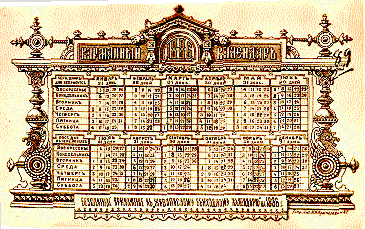 Only
in 1885 at last was the right to issue calendars received by local authorities.
Developing capitalism required constant and exact temporary accounts and
the rather cheap calendars were necessary for daily usage in industrial,
especially financial spheres, and for all layers of the population, beginning
from a rich man and finishing with the simple worker. Only in 1885 did
Russia began the universal release of cheap sheets - calendars of a modern
kind, including pocket had began. But these issues already on the next
year marked the beginning of a history of the domestic pocket sheet - calendar.
Only
in 1885 at last was the right to issue calendars received by local authorities.
Developing capitalism required constant and exact temporary accounts and
the rather cheap calendars were necessary for daily usage in industrial,
especially financial spheres, and for all layers of the population, beginning
from a rich man and finishing with the simple worker. Only in 1885 did
Russia began the universal release of cheap sheets - calendars of a modern
kind, including pocket had began. But these issues already on the next
year marked the beginning of a history of the domestic pocket sheet - calendar.
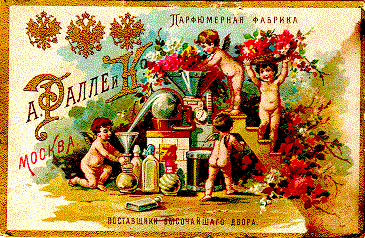 Pocket
calendars of pre-revolutionary Russia can be divided into three basic groups.
The first group are calendars of trade advertising. They were issued colourfully
and with taste and made by stamping, including gold being frequently applied.
These calendars focused, basically, on women, were decorated with colours,
small angels, romantic or humorous pictures. There were calendars with
primitive pictures, designed for less educated layers of the population.
There were calendars in French, which not necessarily meant French firms,
but only hinted that the promoted goods might be from France. This past
century has not changed so much in this respect.
Pocket
calendars of pre-revolutionary Russia can be divided into three basic groups.
The first group are calendars of trade advertising. They were issued colourfully
and with taste and made by stamping, including gold being frequently applied.
These calendars focused, basically, on women, were decorated with colours,
small angels, romantic or humorous pictures. There were calendars with
primitive pictures, designed for less educated layers of the population.
There were calendars in French, which not necessarily meant French firms,
but only hinted that the promoted goods might be from France. This past
century has not changed so much in this respect.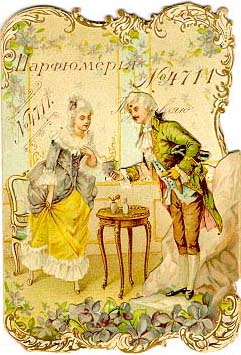
The materials for pocket calendars diversified. The calendars were printed on paper and cardboard, on metal, silk and leather. In the second decade of the twentieth century, there were calendars on aluminum, a metal only beginning to enter into life at that time. These were ordered as a rule from Germany. It is necessary to say that quality of the graphic arts industry of that time for separate calendars has not been surpassed even until present time.
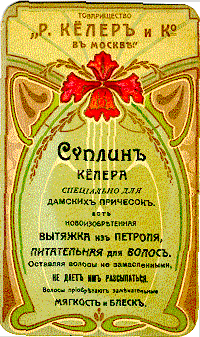 Imprinted,
colourful, cut out on figure, and sometimes, even, with natural gold, they
looked superb. Some of these calendars led one to assume that known artists
had participated in their preparation and release. Such, for example, were
calendars issued by the order of the company "R.Keller & Co in Moscow
", excellently executed in a style referred to as "Russian modern".
Imprinted,
colourful, cut out on figure, and sometimes, even, with natural gold, they
looked superb. Some of these calendars led one to assume that known artists
had participated in their preparation and release. Such, for example, were
calendars issued by the order of the company "R.Keller & Co in Moscow
", excellently executed in a style referred to as "Russian modern".
The second group of pocket calendars were for business firms. Basically for the insurance companies with trade advertising designed for a man's business quota and the like. Also included in this group are calendars of a Guard s economic society and of civil engineering firms, etc. In these calendars the information was the main theme. This group is distinguished by this information content without pictures. In calendars of the insurance companies, the sum of the insurance claims paid for the previous years was the main topic.

Calendars issued by the Sytin publishing house stand separately as they were not about advertising. They, as well as everything that Sytin made, served to the purposes of national education and contained pictures, devoted to the main anniversary of forthcoming year and with the maximal amount of information designed for the least educated part of the population. It is interesting, that pocket calendars of Sytin are seen rather seldom in private collections and, on the contrary, are often in museums. The practically obligatory subject of these calendars were the lives of simple people. In museums, where an image of family life of the peasant or worker has been reconstructed, Sytin calendars are necessarily present, more often pasted on any subject of old furniture: a case or chest. It is interesting also, that on calendars issued by the Sytin publishing house is the obligatory order of a firm price of only 5 kopeks.
Much we can see on pre-revolutionary pocket calendars: a Russian pavilion at the World exhibition in Paris held in 1900 and the subjects of perfumery and cosmetics, costumes and clothes of those years. It should be said that also the war, as well as other events of the day, were widely used as subjects for trade advertising. It is interesting to note how the progression of the war was reflected in calendars of the day.

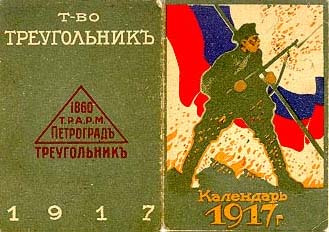
So, the calendar for 1915 issued at the end of 1914 by the order of the company "Emile Cindel in Moscow" shows us three soldiers from the three allied armies of the Antanta alliance. On a calendar issued on the order of the Petrograd company "Triangle" for 1916, already is represented a not cheerful and tiring Russian soldier. By 1917 a similar "Triangle" calendar already shows a malicious and completely worn out soldier on a background of burning huts. He, abused and malicious, will later support the same year a First of February revolution and the October revolution of the bolsheviks. The artists, whether intended or not, very precisely noticed the tendency.
At the end of 1916 the Petrograd publishing house "Otto Kirchner" issues a calendar for 1917. It was without pictures and advertising only listing holidays. In the autumn of 1917, the same publishing house issues an absolutely similar calendar for 1918. This calendar is completely identical but between them is an epoch. Now holidays coincide only with the church and all holidays connected with the imperial family have disappeared. However, by January 1, 1918, when this second calendar should begin to carry out its practical functions, it had already become outdated. Bolsheviks came to authority, other history began, and other calendars were issued.